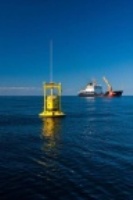Ocean Power Technologies has revealed that it has installed an innovative autonomous wave energy device for sea trials. The autonomous PowerBuoy is produced and designed by OPT as part of the U.S Navy’s Littoral Expeditionary Autonomous PowerBuoy (LEAP) program which aims at providing maritime surveillance and coastal security.
 LEAP Autonomous PowerBuoy Deployed off New Jersey
LEAP Autonomous PowerBuoy Deployed off New Jersey
The new PowerBuoy is much smaller than the standard utility PowerBuoy and provides an exclusive power-take off and energy storage alternatives on-board. The Buoy also supplies off-grid clean energy at remotely located places in the ocean that assist a number of monitoring and maritime security activities.
The power generated by the Buoy is sufficient for sophisticated vessel detection and tracking for maritime surveillance at lower levels. This helps in the maritime surveillance activities conducted near coast, littoral zones and harbours. The data and systems architecture for the radar network has been provided by Mikros Systems. The LEAP PowerBuoy system eliminates the hassles of using diesel generators for providing power at remote ocean locations by providing continuous power supply irrespective of the wave conditions even at zero-wave sea conditions for communication systems and radar. No additional maintenance of the system is required for the initial three years of operation.
The CEO of OPT, Charles F. Dunleavy, said that the PowerBuoy was the first grid-independent product in their product line for ocean applications. He added that the PowerBuoy provides uninterrupted power for sensors and other communication equipment to operate continuously. The LEAP system was initiated on the August 11, 2011 by a US Coast Guard vessel and it will be conducting the testing activities at a location 20 mi. off the coast of New Jersey. From this location the Buoy will be integrated with the land-based radar network operated by the Rutgers University for providing ocean current mapping data for the National Oceanographic and Atmospheric Administration (NOAA) and assist the US Coast Guard in search and rescue operations.